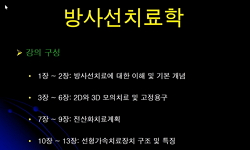방사선 치료에서 부정확한 환자 셋업이 표적에 전달되는 선량에 미치는 영향과 치료 마진과의 연관성을 몬테칼로 기법을 사용한 전산모사를 통하여 분석하였다. 실제 방사선 치료를 받은 ...
http://chineseinput.net/에서 pinyin(병음)방식으로 중국어를 변환할 수 있습니다.
변환된 중국어를 복사하여 사용하시면 됩니다.
- 中文 을 입력하시려면 zhongwen을 입력하시고 space를누르시면됩니다.
- 北京 을 입력하시려면 beijing을 입력하시고 space를 누르시면 됩니다.

몬테칼로 전산모사를 이용한 셋업오차가 임상표적체적에 전달되는 선량과 셋업마진에 대하여 미치는 영향 평가 = Evaluation of Setup Uncertainty on the CTV Dose and Setup Margin Using Monte Carlo Simulation
한글로보기https://www.riss.kr/link?id=A100841474
-
저자
조일성 (서울아산병원) ; 곽정원 (울산대학교) ; 조병철 (울산대학교) ; 김종훈 (울산대학교) ; 안승도 (울산대학교) ; 박성호 (울산대학교) ; Cho, Il-Sung ; Kwark, Jung-Won ; Cho, Byung-Chul ; Kim, Jong-Hoon ; Ahn, Seung-Do ; Park, Sung-Ho
- 발행기관
- 학술지명
- 권호사항
-
발행연도
2012
-
작성언어
Korean
-
주제어
세기조절 방사선치료 ; 셋업 오차 ; 마진 ; 전산 모사 ; 치료계획
-
등재정보
KCI등재
-
자료형태
학술저널
- 발행기관 URL
-
수록면
81-90(10쪽)
-
KCI 피인용횟수
0
- 제공처
-
0
상세조회 -
0
다운로드
부가정보
국문 초록 (Abstract)
방사선 치료에서 부정확한 환자 셋업이 표적에 전달되는 선량에 미치는 영향과 치료 마진과의 연관성을 몬테칼로 기법을 사용한 전산모사를 통하여 분석하였다. 실제 방사선 치료를 받은 직장암 환자에 대한 임상표적체적(CTV: Clinical Target Volume) 및 주요장기의 구조와 치료계획 시스템(Eclipse 8.9, USA)을 이용하여 수립된 세기조절 방사선치료계획에서의 선량분포에 대한 데이터를 전산모사에서 사용하였다. 전산모사 프로그램은 리눅스환경에서 오픈소스인 ROOT 라이브러리와 GCC를 기반으로 본 연구를 위하여 개발되었다. 환자셋업오차의 확률분포를 정규분포로 가정한 것에 따라 무작위로 생성된 크기만큼 셋업이 부정확한 경우를 모사하여 임상표적체적에서의 선량분포의 변화와 오차크기에 따른 마진크기를 3차원입체조형 방사선치료에 사용되는 마진공식과 비교분석 하였다. 셋업오차 생성에 사용된 정규분포의 표준편차 크기는 1 mm부터 10 mm까지 1 mm간격으로 두었으며 계통오차와 통계오차별로 2,000번 전산모사했다. 계통오차의 경우 전산모사에 사용된 표준편차가 커질수록 임상표적체적에 조사되는 최소선량 $D_{min}^{stat{\cdot}}$은 100.4%에서 72.50%로 감소하였고 평균선량 $\bar{D}_{syst{\cdot}}$도 100.45%에서 97.88%로 감소한 반면에 표준편차${\Delta}D_{sys}$는 0.02%에서 3.33%로 증가하였다. 통계오차의 경우 최소선량 $D_{min}^{rand{\cdot}}$은 100.45%에서 94.80%감소하였고 평균선량 $\bar{D}_{syst{\cdot}}$도 100.46%에서 97.87%로 감소하였으며 표준편차 ${\Delta}D_{rand}$는 0.01%에서 0.63%로 증가하였다. 그리고 마진공식으로부터 전산모사에 사용된 셋업오차에 해당되는 마진크기를 구하고 모집단비율(population ratio)을 정의하여 기존 마진공식의 목적이 세기조절방사선치료에 만족함을 확인했다. 개발된 전산모사 프로그램은 해당 환자의 치료계획 정보를 직접 사용하므로 직장암만 아니라 두경부암, 전립선암 등 여러 환부에 적용 가능하며 셋업오차 및 선량변화에 연관된 연구에도 사용할 수 있을 것으로 사료된다.
다국어 초록 (Multilingual Abstract)
The effect of setup uncertainties on CTV dose and the correlation between setup uncertainties and setup margin were evaluated by Monte Carlo based numerical simulation. Patient specific information of IMRT treatment plan for rectal cancer designed on ...
The effect of setup uncertainties on CTV dose and the correlation between setup uncertainties and setup margin were evaluated by Monte Carlo based numerical simulation. Patient specific information of IMRT treatment plan for rectal cancer designed on the VARIAN Eclipse planning system was utilized for the Monte Carlo simulation program including the planned dose distribution and tumor volume information of a rectal cancer patient. The simulation program was developed for the purpose of the study on Linux environment using open source packages, GNU C++ and ROOT data analysis framework. All misalignments of patient setup were assumed to follow the central limit theorem. Thus systematic and random errors were generated according to the gaussian statistics with a given standard deviation as simulation input parameter. After the setup error simulations, the change of dose in CTV volume was analyzed with the simulation result. In order to verify the conventional margin recipe, the correlation between setup error and setup margin was compared with the margin formula developed on three dimensional conformal radiation therapy. The simulation was performed total 2,000 times for each simulation input of systematic and random errors independently. The size of standard deviation for generating patient setup errors was changed from 1 mm to 10 mm with 1 mm step. In case for the systematic error the minimum dose on CTV $D_{min}^{stat{\cdot}}$ was decreased from 100.4 to 72.50% and the mean dose $\bar{D}_{syst{\cdot}}$ was decreased from 100.45% to 97.88%. However the standard deviation of dose distribution in CTV volume was increased from 0.02% to 3.33%. The effect of random error gave the same result of a reduction of mean and minimum dose to CTV volume. It was found that the minimum dose on CTV volume $D_{min}^{rand{\cdot}}$ was reduced from 100.45% to 94.80% and the mean dose to CTV $\bar{D}_{rand{\cdot}}$ was decreased from 100.46% to 97.87%. Like systematic error, the standard deviation of CTV dose ${\Delta}D_{rand}$ was increased from 0.01% to 0.63%. After calculating a size of margin for each systematic and random error the "population ratio" was introduced and applied to verify margin recipe. It was found that the conventional margin formula satisfy margin object on IMRT treatment for rectal cancer. It is considered that the developed Monte-carlo based simulation program might be useful to study for patient setup error and dose coverage in CTV volume due to variations of margin size and setup error.
참고문헌 (Reference)
1 Jin JY, "Use of the BrainLAB ExacTrac X-Ray 6D system in image-guided radiotherapy" 33 : 124-134, 2008
2 Van Herk M, "The Probability of correct target dosage: Dose-Population histograms for deriving treatment margins in radiotherapy" 47 : 1121-1135, 2000
3 Samuelian JM, "Reduced acute bowel toxicity in patients treated with intensitymodulated radiotherapy for rectal cancer" 82 (82): 1981-1987, 2012
4 Matsumoto M, "Mersenne Twistor: A 623-diminsionally equidistributed uniform pseudorandom number generator" 8 : 3-30, 1998
5 Bijhold J, "Maximizing setup accuracy using portal images as applied to a conformal boost technique for prostatic cancer" 24 : 261-271, 1992
6 Huang E, "Intrafraction prostate motion during IMRT for prostate cancer" 53 : 261-268, 2002
7 Guerrero Urbano MT, "Intensity-modulated radiotherapy in patients with locally advanced rectal cancer reduces volume of bowel treated to high dose levels" 65 (65): 907-916, 2006
8 Chen AM, "Evaluation of the planning target volume in the treatment of head and neck cancer with intensity-modulated radiotherapy: what is the appropriate expansion margin in the setting of daily image guidance?" 81 (81): 943-949, 2011
9 Britton KR, "Evaluation of internd intrafraction organ motion during intensity modulated radiation therapy (IMRT) for localized prostate cancer measured by a newly developed on-board image-guided system" 23 (23): 14-24, 2005
10 Van Herk M, "Errors and Margins in Radiotherapy" 14 (14): 52-64, 2004
1 Jin JY, "Use of the BrainLAB ExacTrac X-Ray 6D system in image-guided radiotherapy" 33 : 124-134, 2008
2 Van Herk M, "The Probability of correct target dosage: Dose-Population histograms for deriving treatment margins in radiotherapy" 47 : 1121-1135, 2000
3 Samuelian JM, "Reduced acute bowel toxicity in patients treated with intensitymodulated radiotherapy for rectal cancer" 82 (82): 1981-1987, 2012
4 Matsumoto M, "Mersenne Twistor: A 623-diminsionally equidistributed uniform pseudorandom number generator" 8 : 3-30, 1998
5 Bijhold J, "Maximizing setup accuracy using portal images as applied to a conformal boost technique for prostatic cancer" 24 : 261-271, 1992
6 Huang E, "Intrafraction prostate motion during IMRT for prostate cancer" 53 : 261-268, 2002
7 Guerrero Urbano MT, "Intensity-modulated radiotherapy in patients with locally advanced rectal cancer reduces volume of bowel treated to high dose levels" 65 (65): 907-916, 2006
8 Chen AM, "Evaluation of the planning target volume in the treatment of head and neck cancer with intensity-modulated radiotherapy: what is the appropriate expansion margin in the setting of daily image guidance?" 81 (81): 943-949, 2011
9 Britton KR, "Evaluation of internd intrafraction organ motion during intensity modulated radiation therapy (IMRT) for localized prostate cancer measured by a newly developed on-board image-guided system" 23 (23): 14-24, 2005
10 Van Herk M, "Errors and Margins in Radiotherapy" 14 (14): 52-64, 2004
11 Mageras GS, "Computerized design of target margins for treatment uncertainties in conformal radiotherapy" 43 (43): 437-445, 1999
12 Duthoy W, "Clinical implementation of intensity-modulated arc therapy (IMAT) for rectal cancer" 60 (60): 794-806, 2004
13 ROOT, "An Object Oriented Data Analysis Framework"
14 Bel A, "A verification procedure to improve patient set-up accuracy using portal images" 29 (29): 253-260, 1993
15 de Boer HC, "A protocol for the reduction of systematic patient setup errors with minimal portal imaging workload" 50 (50): 1350-1365, 2001
16 Killoran JH, "A numerical simulation of organ motion and daily setup uncertainties: implications for radiation therapy" 37 (37): 213-221, 1997
17 Mageras GS, "A method of incorporating organ motion uncertainties into three-dimensional conformal treatment plans" 35 (35): 333-342, 1996
18 "A Phase II Evaluation of Dose-Painted IMRT in Combination with 5-Fluorouracil and Mitomycin-C for Reduction of Acute Morbidity in Carcinoma of the Anal Canal"
동일학술지(권/호) 다른 논문
-
A Study of Optimized MRI Parameters for Polymer Gel Dosimetry
- Korean Society of Medical Physics
- 조삼주
- 2012
- KCI등재
-
연속촬영 전자조사 문 영상을 이용한 오프라인 기반 치료 중 내부 장기 움직임 확인 시스템의 개발
- 한국의학물리학회
- 주상규
- 2012
- KCI등재
-
치료테이블과 콜리메이터가 전립선암 래피드아크 치료계획의 선량분포에 미치는 영향
- 한국의학물리학회
- 김형동
- 2012
- KCI등재
-
간원개에 위치한 종양에 대한 Anisotropic Analyticalal Algorithm과 Pencil Beam Convolution 알고리즘에 따른 전달선량 비교
- 한국의학물리학회
- 박병도
- 2012
- KCI등재
분석정보
인용정보 인용지수 설명보기
학술지 이력
| 연월일 | 이력구분 | 이력상세 | 등재구분 |
|---|---|---|---|
| 2024 | 평가예정 | 재인증평가 신청대상 (재인증) | |
| 2021-01-01 | 평가 | 등재학술지 선정 (계속평가) |  |
| 2019-01-01 | 평가 | 등재후보학술지 선정 (신규평가) |  |
| 2016-12-01 | 평가 | 등재후보 탈락 (계속평가) | |
| 2015-12-01 | 평가 | 등재후보로 하락 (기타) |  |
| 2014-07-10 | 학술지명변경 | 외국어명 : Korean Journal of Medical Physics -> PROGRESS in MEDICAL PHYSICS |  |
| 2011-01-01 | 평가 | 등재학술지 유지 (등재유지) |  |
| 2009-01-01 | 평가 | 등재 1차 FAIL (등재유지) |  |
| 2006-01-01 | 평가 | 등재학술지 선정 (등재후보2차) |  |
| 2005-01-01 | 평가 | 등재후보 1차 PASS (등재후보1차) |  |
| 2003-07-01 | 평가 | 등재후보학술지 선정 (신규평가) |  |




 ScienceON
ScienceON



